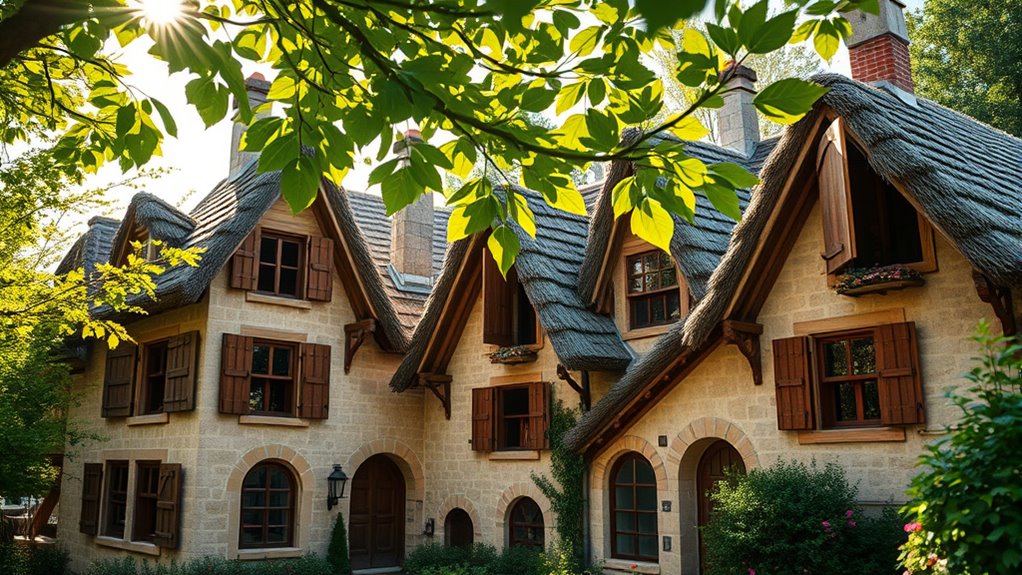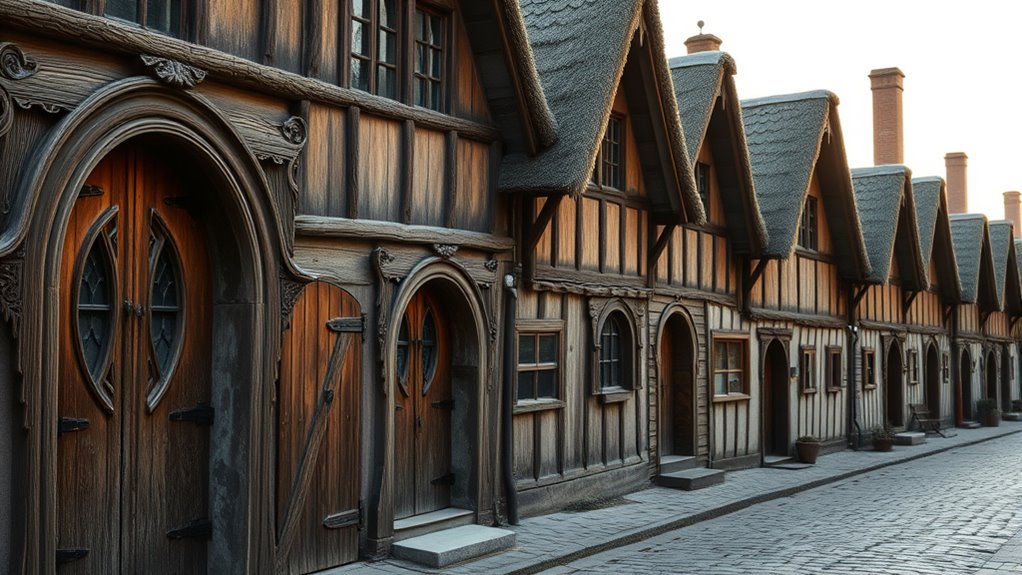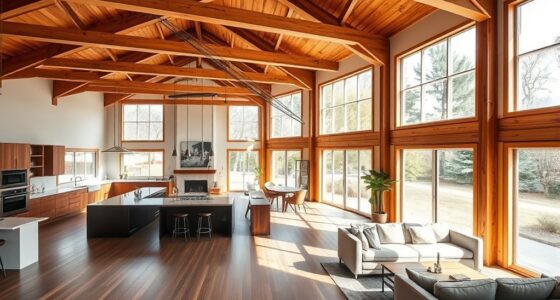Tiny houses draw on medieval origins that focused on efficient, durable, and resourceful design. Back then, homes were small out of necessity, built with local materials and craftsmanship to maximize space and sustainability. These principles still inspire modern downsizing, emphasizing eco-friendly living and minimalism. By choosing a tiny house, you connect with centuries of architectural wisdom that values simplicity and practicality. If you keep exploring, you’ll uncover how these ancient ideas shape today’s eco-conscious lifestyle.
Key Takeaways
- Medieval homes were small, functional, built with natural, local materials, emphasizing efficiency and resourcefulness similar to modern tiny houses.
- Early architectural practices prioritized durability and multi-purpose spaces, inspiring contemporary compact design principles.
- Sustainable building methods from the past, like using eco-friendly materials, align with today’s tiny house eco-conscious movement.
- Downsizing reflects centuries-old ideals of simplicity and practicality rooted in medieval resource management.
- Tiny houses serve as modern expressions of historical craftsmanship, merging past ingenuity with current environmental and lifestyle values.

Have you ever wondered if a smaller home could offer a better way of living? Tiny houses, despite their modern popularity, actually have roots that stretch back through history, connecting you to centuries of architectural innovation and lifestyle choices. When you look at the design of these compact dwellings, you might notice influences from historical architecture, which often emphasized efficiency and craftsmanship. Medieval homes, for example, were built small out of necessity, utilizing local materials and simple structures that prioritized function over extravagance. These early designs embody a form of sustainable living long before the term became fashionable. By downsizing your space, you’re not just making a lifestyle choice; you’re reconnecting with centuries of architectural ingenuity that aimed to minimize waste and maximize resourcefulness.
Throughout history, smaller homes were often built with sustainability in mind, making them inherently eco-friendly. Medieval builders used natural materials like wood, stone, and clay, which had minimal environmental impact and could be sourced locally. This tradition of using sustainable materials continues today in tiny house construction, where eco-conscious practices are central. You’re engaging in a form of sustainable living that reduces your carbon footprint, conserves energy, and minimizes waste. Tiny houses require less energy for heating and cooling, and their smaller footprint means you use fewer resources overall. This historical approach to building and living aligns perfectly with current environmental priorities, embodying a lifestyle that respects the planet.
Historically built with natural, local materials, tiny houses promote eco-friendly living that minimizes environmental impact.
Moreover, the compact design of tiny houses echoes the principles of historical architecture, which often focused on creating durable, multi-purpose spaces within limited square footage. Instead of sprawling estates, medieval homes and early urban dwellings prioritized clever use of space—think multi-level layouts, built-in furniture, and efficient storage solutions. These features are still relevant today, as they allow you to maximize every inch of your tiny home. By embracing this tradition, you’re adopting a living style that’s both practical and rooted in centuries of proven design principles. Historical architectural principles continue to inspire modern tiny house designs that value resourcefulness and durability.
Choosing a tiny house means adopting a mindset that values simplicity, sustainability, and historical wisdom. It’s a way to live intentionally, respecting the environment while honoring the craftsmanship of the past. You’re not just downsizing; you’re participating in a movement that finds beauty and purpose in simplicity. The connections to historical architecture and sustainable living remind you that smaller doesn’t mean less—it can mean smarter, more mindful, and more connected to the lessons of our ancestors. In this way, tiny houses serve as modern interpretations of centuries-old ideas, proving that sometimes, less truly is more.
Frequently Asked Questions
How Did Medieval Societies Influence Tiny House Design?
You might find that medieval architecture influences tiny house design through its focus on efficiency and resourcefulness. Medieval societies prioritized social housing and compact structures, which inspired modern tiny homes to maximize space and functionality. These historical designs emphasize simplicity and sustainability, reflecting a legacy of downsizing that you can see today. By studying medieval architecture, you can better understand how small, efficient living spaces evolved from historical social housing needs.
Were Tiny Houses More Common Among the Lower or Upper Classes Historically?
Have you ever wondered which social class historically favored tiny houses? In reality, tiny houses were more common among the lower classes, driven by limited resources and the need for affordability. During different periods, the historical prevalence of small dwellings reflected economic constraints, making tiny homes accessible to those with fewer means. Conversely, the upper classes typically preferred larger, more luxurious residences, emphasizing wealth and status.
What Materials Were Traditionally Used in Medieval Small Dwellings?
You might wonder what materials built medieval small dwellings. Typically, they used traditional construction materials like wattle and daub for walls, timber for framing, and thatch or clay tiles for roofing. Medieval building techniques relied on local resources, making homes affordable and practical. These materials offered insulation and durability, reflecting the resourcefulness of that era’s construction methods. Understanding these materials shows how medieval design prioritized functionality with available resources.
How Did Medieval Downsizing Compare to Modern Tiny House Movements?
Imagine a castle shrinking into a cozy cottage—medieval downsizing mirrored today’s tiny house movement. Back then, social hierarchy dictated space; the less noble had smaller dwellings. Today, tiny house legislation promotes compact living, emphasizing efficiency and affordability. Both eras reflect a desire to simplify life, challenge societal expectations, and adapt to constraints, showing that downsizing isn’t new but a timeless response to social and economic pressures.
Are There Surviving Medieval Tiny Houses or Similar Structures Today?
You won’t find surviving medieval tiny houses like modern ones, but some structures resemble them, such as remnants of medieval wall fortifications and small stone dwellings. These often served defensive purposes or were built using ancient storytelling techniques, passing down craftsmanship. While not tiny houses, they reflect similar principles of efficient space use and resourcefulness, connecting past and present in the ongoing exploration of compact living.
Conclusion
As you consider the tiny house movement, remember its medieval roots remind us that simpler living isn’t just modern trend—it’s a return to times when less meant more. In downsizing, you shed clutter and stress, gaining freedom. Yet, amidst the small space, you find room for reflection and purpose. Sometimes, the smallest homes hold the biggest lessons: that true richness isn’t measured in size, but in what you choose to carry—and what you choose to leave behind.









